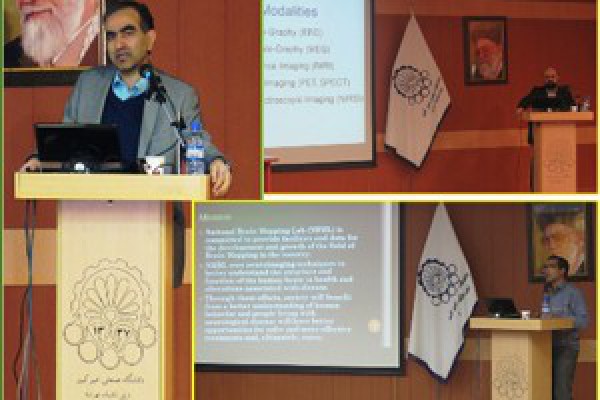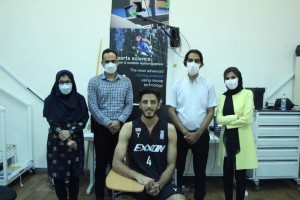First Session of Lecture Series on Human Brain Mapping Arranged by NBML
First Session of Lecture Series on Human Brain Mapping Arranged by NBML
Source: cogc.ir
Lecturers:
 Hamid Soltanian-Zadeh, PhD
Hamid Soltanian-Zadeh, PhD
(Control and Intelligent Processing Center of Excellence (CIPCE); School of Electrical and Computer Engineering, University of Tehran, Tehran, Iran; School of Cognitive Sciences, Institute for Studies in Physics and Mathematics (IPM), Tehran, Iran; Medical Image Analysis Laboratory, Henry Ford Health System, Detroit, Michigan, USA)
Title of the Talk: Estimation of Brain Networks at Rest using Functional Magnetic Resonance Imaging
Abstract: Functional changes in the brain may occur before structural changes are detectable by the existing noninvasive anatomical imaging modalities. Therefore, investigation of functional connectivity using resting state functional magnetic resonance imaging (rs-fMRI) data has become a focus of attention in recent years to detect functional connectivity of the brain and use the results to characterize the brain in health and disease and to improve diagnosis and treatment of neurological disorders. To this end, the brain is modeled as a connected network of nodes and connectivity matrices are estimated from the rs-fMRI data. The nodes may be selected based on the structural or functional parcellation of the brain using model-based or model-free (data-driven) methods. The entire connectivity matrix or specific connections between two groups of nodes may be compared between two groups. Whole brain connectivity analysis can reveal major differences between the two groups but requires a huge number of samples and complicated statistical analysis. On the other hand, comparison of brain connectivity using a limited number of regions can be done for the two groups based on a manageable number of samples and conventional statistical analysis methods. In this presentation, we will briefly describe state-of-the-art brain connectivity analysis approaches using a variety of neuroimaging data modalities and explain advantages and disadvantages of these modalities. Then, we will introduce the rs-fMRI data properties and present the processing steps to estimate the brain connectivity from this data. Next, we will explain the preliminary results we have obtained in the application of the brain connectivity analysis using rs-fMRI data for the diagnosis and prognosis of drug-resistant mesial temporal lobe epilepsy patients. At the end, we will present concluding remarks and directions for the future work.
 Reza Rostami, PhD
Reza Rostami, PhD
(Associate professor, University of Tehran)
Title of the Talk: An overview of EEG signal processing algorithms for the detection of EEG biomarkers of treatment response in depression
Abstract: Depression is the most common psychiatric disorder that causes impairments in education, occupational and social functions. The prevalence of depression worldwide (among 60 countries) is 3.2% while 21 million people in Europe and 15 million people in the United States suffer from depression. The World Health Organization predicts depression as the second burden of disease in 2020. Currently, depression is the fourth leading cause of disability worldwide. The annual cost of depression is 118 million Euros in Europe and 400 million Dollars in the United States. Currently, a combination of antidepressant medications and psychotherapy is the most effective treatment for depression while their individual effectiveness equals any Alternative medicine treatment or control group. Less than 50% of MDD patients respond to their first consumed antidepressant and only 30% experience the full recovery. Most of the patients experience a long period of trial and error before finding the right antidepressant. A new research scope that has attracted a lot of attention recently is the use of biomarkers to predict the response to treatment. Different genetic, metabolic, neuroendocrinology, neuroimaging and neurophysiology parameters are proposed as potential biomarkers of response to antidepressant treatment, but none has been approved. One neurophysiologic biomarker of response to treatment that has had promising results is EEG. EEG-derived biomarkers for the prediction of response to treatment in patients under biological treatments for depression consists of activity band frequency, hemispheric alpha asymmetry, theta cordance, the antidepressant treatment response index (ATR), event-related potentials- ERP. We will review the studies in this field and consider the strengths and weaknesses of each of EEG biomarkers in the detection of response to treatment.
 Gholam-Ali Hossein-Zadeh, PhD
Gholam-Ali Hossein-Zadeh, PhD
(Deputy of scientific and technology, NBML; Associate Professor, BioElectric, School of Electrical and Computer Engineering, College of Engineering, University of Tehran)
Title of the Talk: Introducing NBML, its goals, and its services.





Related Posts